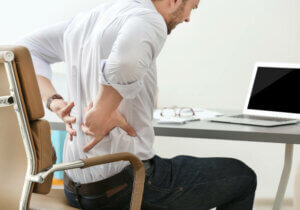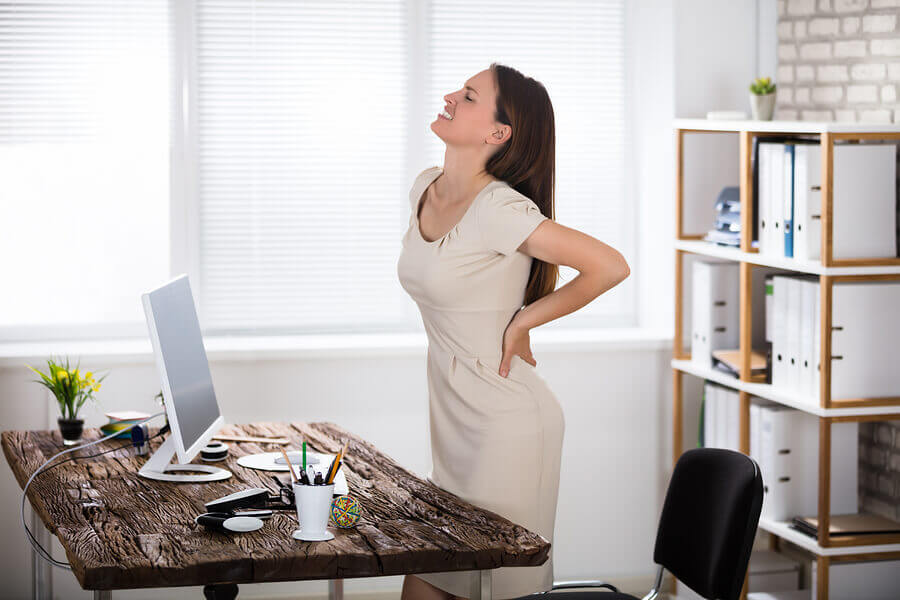How to Relieve Lower Back Pain

How long does it take for a muscle to recover after an injury? Did you know that your body can suffer from various musculoskeletal pathologies due to the behaviors that you adopt on a day-to-day basis? One of the most frequent manifestations of musculoskeletal pathologies is lower back pain. Lower back pain is a really common ailment, therefore, it’s important to know how to relieve it when it occurs.
What are the causes of lower back pain?
Lower back pain often occurs when we don’t give the body what it needs. The distribution of weight on the pelvis has evolved in such a way that we have to walk for several miles a day in order to keep it in perfect condition.
In addition, the back muscles need to be worked out in order to stay fit. Improper posture can also affect the vertebrae and the body’s soft tissues.
In other words, the human body has been molded over centuries to work in a certain way and it can be improved and strengthened by certain stimuli. However, the current way of life has alienated people from what they used to do during the earliest stages of human evolution.
Prevention
So, what’s the best way to prevent lower back pain? The answer to this question is exercise and avoiding harmful postures.
Although most of us can’t afford the time to walk for several miles a day, we can at least walk for 30 minutes a day. This alone can have a great impact on your lower back health. Walking can also help with the aforementioned distribution of forces. It also strengthens the paravertebral musculature.

The paravertebral musculature is made up of muscle fibers that turn into fat if they don’t receive the right stimuli. Pain can be one of the symptoms of this change.
As for posture, it’s important to sit properly while at work and to lie down properly at night. Avoiding improper posture can significantly reduce the risks of lower back pain.
How to relieve lower back pain
If you’re not able to prevent lower back pain it’s important to learn how to relieve it. There are certain measures you should take immediately in order to prevent the pain from becoming chronic. Taking early measures can also help to reduce mobility limitations.
When faced with an episode of acute lower back pain, the first measure to take is to rest and apply a cold pack to the area. Anti-inflammatory medication can also be used. According to research published in the Lancet, it’s advisable to limit the use of anti-inflammatories.
After 24 to 48 hours or when the acute pain fades, you can move on to the next recovery phase. During this phase, light physical exercise such as walking can be useful.
During the second phase, it’s also wise to apply heat to the area and to consult a physiotherapist. Your physiotherapist will be able to advise you on the specific exercises and stretching techniques. They may also apply therapeutic methods such as health therapy or analgesic electrotherapy. Physiotherapists are also trained to assess whether there is a more serious underlying pathology that may be causing your back pain.
If the physiotherapist suspects an underlying pathology, consult your medical professional in order for them to perform the relevant tests. If that’s not the case, rehabilitation can continue which will most likely lead to a full recovery.

Avoid lifting heavy objects during the first weeks of recovery. It’s also important to avoid rotating your back during recovery. Spinal flexion and rotation are among the most damaging gestures for the lower back.
Finally, it’s important to take psychological aspects into account. A study published in the American Journal of Epidemiology showed that a negative attitude can make recovery more difficult after an injury. Therefore, it’s important to avoid stress, fear, and negative thoughts.
A positive prognosis for relieving back pain
The first thing you should know if you suffer from lower back pain is that it’s likely you’ll fully regain mobility. It’s also likely that the pain will fade. Rest when you have acute pain and apply cold or heat. As you recover you can start light exercise routines in order to fully relieve your back pain.
Remember that what you do after recovery is also important. All your hard work won’t be worth anything if you continue sitting down incorrectly for eight hours while you work.
In conclusion, pay more attention to your posture, use the stairs instead of the elevator every once in a while. Pilates, swimming, or any anaerobic exercises can be helpful when it comes to strengthening the back in a natural way.
How long does it take for a muscle to recover after an injury? Did you know that your body can suffer from various musculoskeletal pathologies due to the behaviors that you adopt on a day-to-day basis? One of the most frequent manifestations of musculoskeletal pathologies is lower back pain. Lower back pain is a really common ailment, therefore, it’s important to know how to relieve it when it occurs.
What are the causes of lower back pain?
Lower back pain often occurs when we don’t give the body what it needs. The distribution of weight on the pelvis has evolved in such a way that we have to walk for several miles a day in order to keep it in perfect condition.
In addition, the back muscles need to be worked out in order to stay fit. Improper posture can also affect the vertebrae and the body’s soft tissues.
In other words, the human body has been molded over centuries to work in a certain way and it can be improved and strengthened by certain stimuli. However, the current way of life has alienated people from what they used to do during the earliest stages of human evolution.
Prevention
So, what’s the best way to prevent lower back pain? The answer to this question is exercise and avoiding harmful postures.
Although most of us can’t afford the time to walk for several miles a day, we can at least walk for 30 minutes a day. This alone can have a great impact on your lower back health. Walking can also help with the aforementioned distribution of forces. It also strengthens the paravertebral musculature.

The paravertebral musculature is made up of muscle fibers that turn into fat if they don’t receive the right stimuli. Pain can be one of the symptoms of this change.
As for posture, it’s important to sit properly while at work and to lie down properly at night. Avoiding improper posture can significantly reduce the risks of lower back pain.
How to relieve lower back pain
If you’re not able to prevent lower back pain it’s important to learn how to relieve it. There are certain measures you should take immediately in order to prevent the pain from becoming chronic. Taking early measures can also help to reduce mobility limitations.
When faced with an episode of acute lower back pain, the first measure to take is to rest and apply a cold pack to the area. Anti-inflammatory medication can also be used. According to research published in the Lancet, it’s advisable to limit the use of anti-inflammatories.
After 24 to 48 hours or when the acute pain fades, you can move on to the next recovery phase. During this phase, light physical exercise such as walking can be useful.
During the second phase, it’s also wise to apply heat to the area and to consult a physiotherapist. Your physiotherapist will be able to advise you on the specific exercises and stretching techniques. They may also apply therapeutic methods such as health therapy or analgesic electrotherapy. Physiotherapists are also trained to assess whether there is a more serious underlying pathology that may be causing your back pain.
If the physiotherapist suspects an underlying pathology, consult your medical professional in order for them to perform the relevant tests. If that’s not the case, rehabilitation can continue which will most likely lead to a full recovery.

Avoid lifting heavy objects during the first weeks of recovery. It’s also important to avoid rotating your back during recovery. Spinal flexion and rotation are among the most damaging gestures for the lower back.
Finally, it’s important to take psychological aspects into account. A study published in the American Journal of Epidemiology showed that a negative attitude can make recovery more difficult after an injury. Therefore, it’s important to avoid stress, fear, and negative thoughts.
A positive prognosis for relieving back pain
The first thing you should know if you suffer from lower back pain is that it’s likely you’ll fully regain mobility. It’s also likely that the pain will fade. Rest when you have acute pain and apply cold or heat. As you recover you can start light exercise routines in order to fully relieve your back pain.
Remember that what you do after recovery is also important. All your hard work won’t be worth anything if you continue sitting down incorrectly for eight hours while you work.
In conclusion, pay more attention to your posture, use the stairs instead of the elevator every once in a while. Pilates, swimming, or any anaerobic exercises can be helpful when it comes to strengthening the back in a natural way.
All cited sources were thoroughly reviewed by our team to ensure their quality, reliability, currency, and validity. The bibliography of this article was considered reliable and of academic or scientific accuracy.
- D.Hoy, P.Brooks, F.Blyth et al. The Epidemiology of low back pain. Best Practice & Research Clinical Rheumatology. Volume 24, Issue 6, December 2010, Pages 769-781
- C. Maher, M. Underwood, R. Buchbinder. Non-specific low back pain. The Lancet. Volume 389, Issue 10070, 18–24 February 2017, Pages 736-747
- H. Picavet, J. Vlaeyen, J. Schouten. Pain Catastrophizing and Kinesiophobia: Predictors of Chronic Low Back Pain. American Journal of Epidemiology, Volume 156, Issue 11, 1 December 2002, Pages 1028–1034
This text is provided for informational purposes only and does not replace consultation with a professional. If in doubt, consult your specialist.








